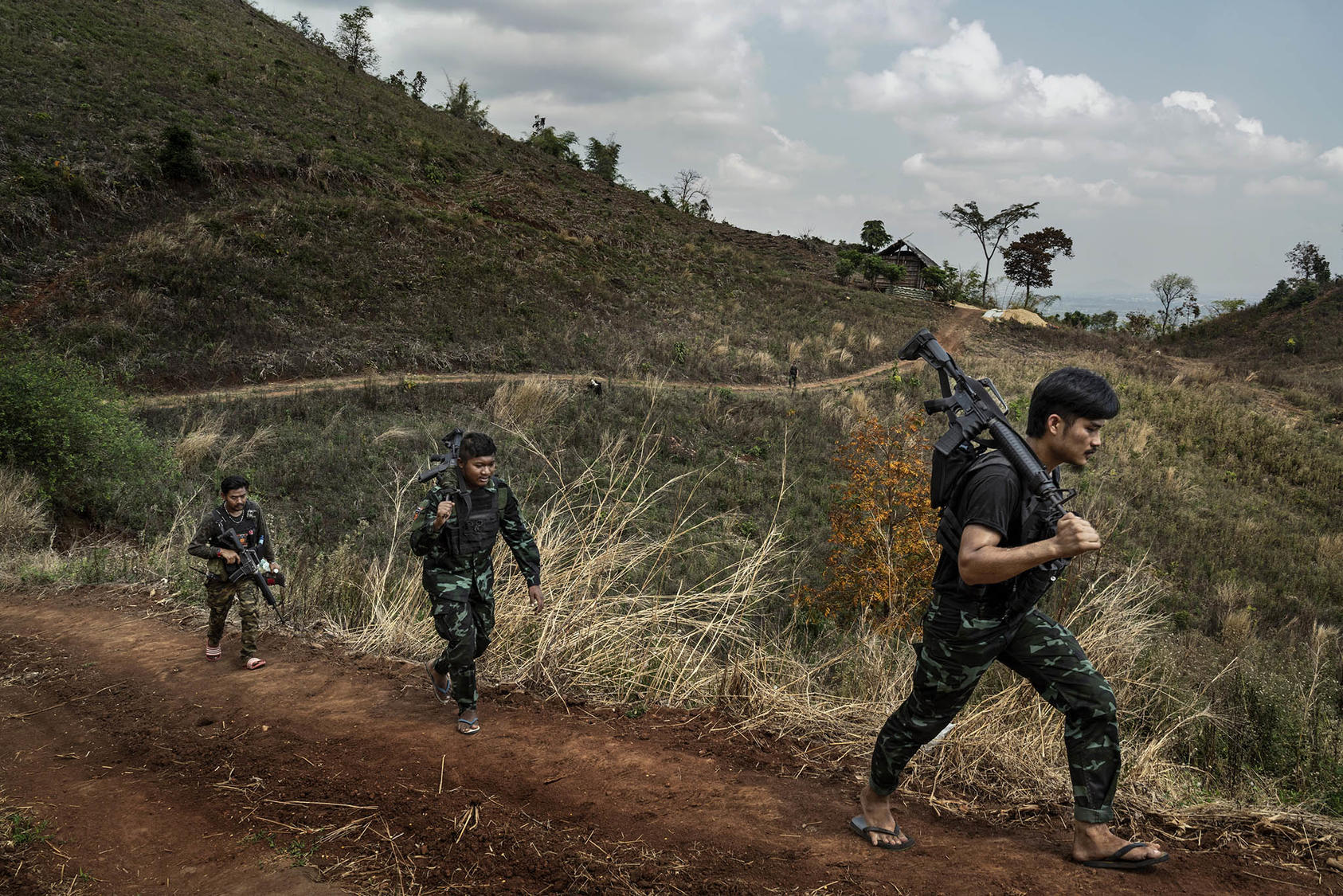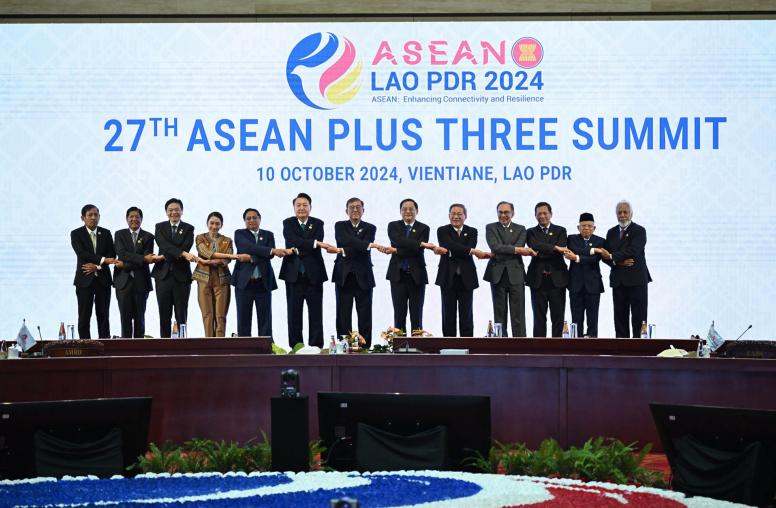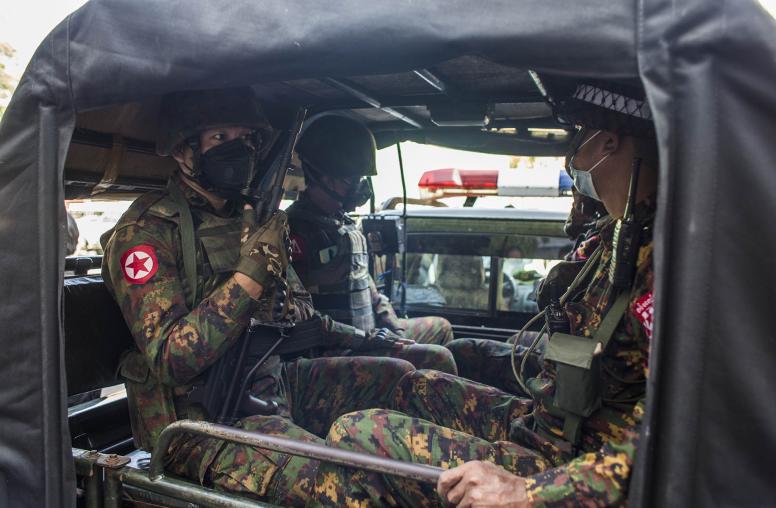Understanding the People’s Defense Forces in Myanmar
The junta is losing control in the face of a strengthening armed resistance.
When the People’s Defense Forces (PDFs) first coalesced in Myanmar in 2021, many viewed them as hastily organized groups of young vigilantes who would be quickly overrun by the junta’s military force, known as the Sit-Tat. Instead, the PDFs have grown in size, organization and capability over the last year and half, and now pose a major threat to the junta’s viability. Though they lack heavy equipment, an advanced command structure and international support, the proliferating PDFs have demonstrated remarkable tactical ingenuity and resilience. If they improve their command structure and weaponry, they could help expand territory under resistance control and hasten the junta’s demise.

Given their fragmented nature and rapid development, the PDFs remain a mystery to most analysts and international policymakers. Benefiting from strong public support, these rebel groups, which have become battle-hardened and more coordinated, now play a crucial, and perhaps decisive, role in the future security landscape of Myanmar.
A New Landscape for Armed Resistance
After tolerating peaceful protests for a few days after its February 2021 coup, the Sit-Tat has committed horrendous atrocities against the protesters, expecting this would subjugate a population unwilling to return to military rule. Instead, it unleashed a revolutionary energy that soon led to the emergence of the PDFs to protect the people from junta atrocities, particularly in areas of the country inhabited by the Buddhist Bamar majority from where the Sit-Tat has historically drawn recruits and political support.
People’s Defense Force is an umbrella term for three types of armed groups that have emerged since the coup: PDFs, Local Defense Forces (LDFs) and People’s Defense Teams (PaKhaPha/PDTs). The PDFs are generally larger armed units formed or recognized by the National Unity Government (NUG), the shadow civilian government formed primarily by democratically elected lawmakers. The PDFs mainly operate under joint command systems established by the NUG and several ethnic armed organizations (EAOs), many of which have been fighting the Sit-Tat for decades.The LDFs are local militias operating autonomously at the local level, often pursuing their own missions separate from the NUG’s. The PDTs are localized guerilla units formed for local defense and security purposes. The PDFs are more regularized military units operating across townships and states/regions, whereas the LDFs and PDTs are self-defense or community security militias operating at the community level.
Acronyms
| C3C | Central Command and Coordination Committee |
| CDF | Chinland Defense Force |
| CJDC | Chinland Joint Defense Committee |
| EAO | Ethnic Armed Organization |
| J2C | Joint Command and Coordination |
| KA | Karenni Army |
| KIA | Kachin Independence Army |
| KNDF | Karenni National Defense Force |
| KNPP | Karenni National Progressive Party |
| KNU | Karen National Union |
| KPDF | Kachin People’s Defense Force |
| LDF | Local Defense Force |
| MDC | Military Division Command |
| NUG | National Unity Government |
| People’s Defense Force | |
| PDT/PaKhaPha | People’s Defense Teams |
People’s Defense Forces
- According to interviews undertaken for this piece, there are roughly 65,000 total PDF troops. Approximately 20 percent of PDF troops are equipped with military-grade weapons and another 40 percent have homemade weapons.
- As of October 2022, there were around 300 PDF battalions with 200 to 500 troops each. Sixty-three additional battalions are awaiting NUG recognition.
- The PDFs operate under the command of the Central Command and Coordination Committee (C3C) and Joint Command and Coordination (J2C), which were established by the NUG and its EAO allies. Most PDFs are primarily loyal to or were formed by the NUG, whereas others, including the powerful Chinland Defense Force (CDF), Karenni National Defense Force (KNDF) and Kachin People’s Defense Force (KPDF), operate under the C3C but are not otherwise aligned with the NUG. Regardless of their national-level affiliation, PDFs work most closely with military division commands (MDCs), which operate semi-autonomously of the C3C and J2C. Recent PDF deployment and operations indicate that MDCs are becoming more involved in PDF operational strategy.
- There are currently three MDCs. Some 200 PDF units currently operate under the command of MDC 1 with responsibility for the Kachin, Anyar(Central Myanmar) and Chin theaters. Approximately 50 PDFs operate in the areas of MDCs 2 and 3 which manage operations in the Karen and Karenni theaters, respectively.
- The PDFs in ethnic areas are operationally commanded by or affiliated with EAOs. For example, the KPDF is under the command of the Kachin Independence Army (KIA), the CDF is under the control of Chinland Joint Defense Committee (CJDC) and the KNDF is closely affiliated with the Karenni Army (KA) of the Karenni National Progressive Party (KNPP).
- The PDFs are systematically formed, trained and equipped as main combat forces by the NUG and its allied EAOs. Each PDF unit is structured triangularly with squads, platoons, companies and battalions of three each. For example, three squads to one platoon, three platoons in one company and three companies in one battalion.
Local Defense Forces
- The NUG estimates that there were 401 LDFs as of April 2022. The LDFs operate more autonomously than the PDTs and PDFs and do not directly interact with the C3C or J2C, but 354 are now informally linked with the NUG. This enhanced coordination is a first step toward integrating the LDFs into the broader command system. One hundred LDFs have been converted to PDFs and dozens have been converted to PDTs.
- Recent analysis estimates that there are at least 30,000 LDF personnel. The LDFs range in size from a dozen to a few thousand personnel. This estimate is highly fluid given that roughly 25 percent of LDF fighters have been converted to PDFs or PDTs over the past six months.
- Mostly formed in mid-March 2021 to protect protesters, the LDFs continue to operate as township-based militias, often led by activists.
- The LDFs are self-funded, primarily through community and diaspora donations. They rely mostly on homemade weapons, though some LDFs are connected with large EAOs which provide training and equipment.
- Operationally, the LDFs engage in irregular warfare through landmines, skirmishes, sabotage and targeted killings. Their primary aim is to deny the junta administrative control over rural areas.
People’s Defense Team
- The PDTs, also known as PaKaPha, are formed by the NUG, and specialize in urban guerilla warfare, basic training for new resistance fighters, logistics, public mobilization and PDF support.
- According to the NUG, the PDTs have been formed in 250 out of 330 townships. Over the past six months, they have significantly expanded formation at the village level. The PDTs are most active in central Myanmar, particularly Sagaing and Magwe regions.
- Although PDTs operate at the village level, many coordinate at the township level. A single township can, therefore, have as many as 2,000 PDT members coordinating. Most PDTs are primarily equipped with homemade small arms.
- The PDTs are the foundational resistance force, linking communities with the broader resistance movement.
The Continued Development of the PDFs
As nonviolent resistance methods have become prohibitively dangerous for many because of the Sit-Tat’s crackdown, the PDFs, LDFs and PDTs have become the center of the resistance movement. With strong public support and increasingly close coordination with EAOs, they have expanded rapidly despite facing a genocidal Russian-armed and Chinese-backed junta with decades of fighting experience that has no qualms about committing atrocities.
Eighteen months since the coup, the PDFs, LDFs and PDTs are undergoing a transformation from fractious, decentralized and localized resistance forces to a more organized and better equipped military force.
Command Systems
Resistance forces established themselves in the form of a cellular, horizontally networked guerilla force. Faced with the junta’s more aggressive and brutal offensive campaigns, the NUG sought to integrate the disparate civil resistance forces, and to coordinate military operations with allied EAOs under a centralized command system.
In October 2021, the NUG announced the formation of a C3C, a centralized military command structure jointly led by the NUG and its EAOs allies. The C3C includes the NUG, KIA, the KNPP, Chin National Front and the All Burma Students’ Democratic Front. The NUG also negotiated with Karen National Union (KNU), which is not a member of the C3C, to form the J2C to oversee operations of all troops in the KNU area. Although the C3C and J2C are separate commands, the NUG is a key link between these two structures.
Even as the command systems are still developing, overall command is becoming a more cohesive and coordinated command unit, which could help shift the military balance further in favor of the resistance. Importantly, the operation of the C3C and J2C is improving as more PDFs, LDFs and PDTs come under their command. The NUG is now in the process of establishing a war office, which has three departments: general staff, adjutant affairs and quartermaster. The general staff branch oversees military operations whereas adjutant affairs and the quartermaster oversee joint command administration. The key challenge now will be to merge the C3C, J2C and LDFs into a single system.
Arming the Resistance
The armed resistance began with makeshift weapons, such as traditional guns, gas rifles and handmade firearms, and junta leaders mistakenly expected that these ragtag armed rebels could be easily defeated. Unlike in Ukraine, Myanmar’s armed rebellion has received no lethal support from the international community, relying instead on arms being supplied by sympathetic EAOs and purchased on the black market.
Resistance forces have used their own money and public donations to finance arms purchases from EAOs and others. Through its innovative fundraising tactics, the resistance has raised over $55 million, according to interviews with an official of the NUG’s Ministry of Defense undertaken for this article, most of which has been used to fund armed resistance forces. Although this is only a fraction of what is needed, it has far exceeded initial expectations and helped sustain the armed resistance.
In central Myanmar, far from EAOs and the weapons black markets along the border with China, the price of weapons is particularly high, which constrains the PDFs, LDFs and PDTs in that area. In response, resistance forces have produced their own weapons during active war, which is unprecedented in Myanmar’s modern history. According to the author’s research in April 2022, there are over 70 workshops across the country that manufacture rudimentary weapons which serve about 30 percent of localized arms requirements.
Although 60 percent of the PDFs are armed, a smaller proportion — only about 50 percent — of all resistance troops are armed, mostly with locally produced low-quality arms. Strategic armaments such as artillery, anti-air and anti-armored weapons are unavailable to most resistance troops. Without more advanced arms, particularly air-defense weapons, the resistance forces will only be able to engage in limited warfare. Furthermore, despite some success in rural guerilla tactics, it is still difficult to contest junta security control of major urban areas. When the Sit-Tat’s infantry comes under serious assault from the PDFs, they often call in air strikes, artillery and armored units, and the poorly equipped pro-democracy forces retreat.
Public Support
Widespread public support for the resistance forces provides a major advantage over the Sit-Tat’s light infantry force which is now spread thinly across the country. So far, resistance forces have had no trouble recruiting to replace losses and expand their strength, while the Sit-Tat is experiencing defections and recruitment difficulties. However, without meaningful international support, resistance forces remain entirely dependent on local support to sustain themselves and may find it difficult to maintain public goodwill if the Sit-Tat manages to drive a wedge between the resistance movement and the public by killing its supporters and funders and burning down villages perceived to support the resistance.
What’s Next for Resistance Forces?
The PDFs, LDFs and PDTs have demonstrated the ability to inflict heavy causalities on the low-morale and over-stretched Sit-Tat. As a result, the junta is losing control of a wide swath of territory, particularly in rural areas. Moreover, resistance forces are making progress toward overcoming their weaknesses in command and control and weapons.
Mao Zedong once said that, “there is very little hope of destroying a revolutionary guerilla movement after it has survived the first phase and has acquired the sympathetic support of a significant segment (between 15 and 25 percent) of the population.”
Despite facing serious and ferocious crackdowns, Myanmar’s revolutionary guerilla movement has survived the first phase and built widespread public support. Through tactical ingenuity, it is now developing from its rudimentary beginnings into a force that operates at a strategic scale.
The junta has garnered support from regional actors, including China, by claiming to be the only entity that can stabilize the country and provide protection for these actors’ strategic assets and investment. This assertion has become less credible in recent months as the Sit-Tat has not only lost control of most of the country, but has also shown itself to be the primary agent of instability domestically and regionally — launching heavy weapons into Thailand and Bangladesh, actively inciting interreligious violence and committing horrendous atrocities that spur large outflows of refugees. As the junta desperately attempts to regain some degree of control ahead of its sham elections proposed for next summer, it will face a more sophisticated and coordinated resistance force than it has to date.
Ye Myo Hein is a visiting scholar at the U.S. Institute of Peace and a global fellow at the Wilson Center.



